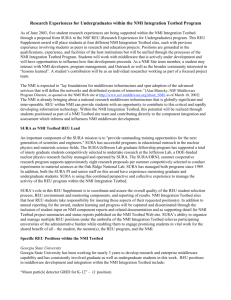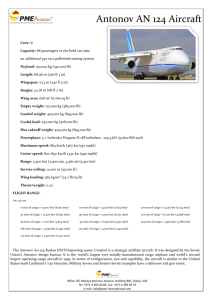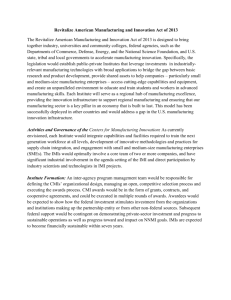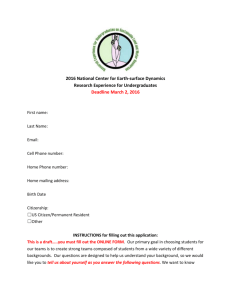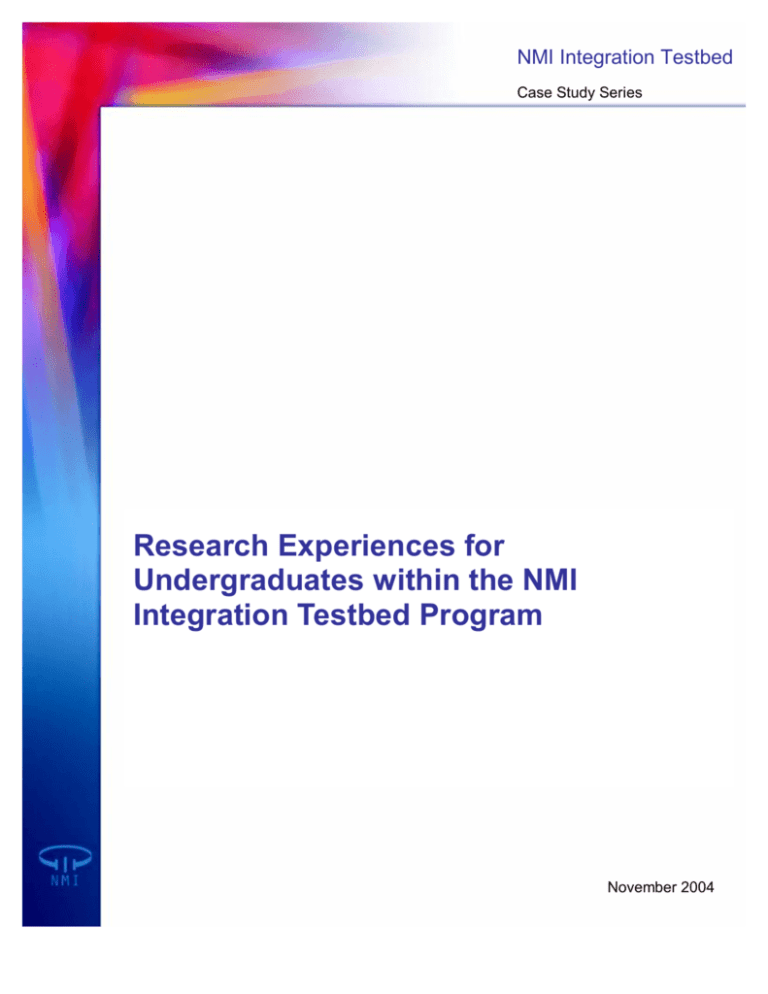
NMI Integration Testbed
Case Study Series
Research Experiences for
Undergraduates within the NMI
Integration Testbed Program
November 2004
NSF Middleware Initiative (NMI) Integration Testbed Case Study Series
Series contact: Mary Fran Yafchak, Southeastern Universities Research Association,
maryfran@sura.org.
The NMI Integration Testbed Program provided practical evaluation of NMI components within
the context of real projects and application scenarios from June 2002 through November 2004.
During that time, NMI Testbed sites collectively submitted over 220 evaluation reports to
middleware component developers as direct feedback into the NMI development cycle. Site
representatives also actively inspired, promoted and facilitated the integration of middleware
throughout their institutions.
The NMI Integration Testbed Case Study Series documents the most significant influences and
outcomes of NMI Testbed sites' middleware integration efforts, highlighting intersections with
established projects, application contexts and influences, drivers for innovation, decision points
and challenges. Through this documentation, the work of these pioneering institutions is captured
to provide a breadth of insight and approaches for others to use towards successful middleware
development and deployment.
This NMI Integration Testbed Case Study Series is sponsored by the National Science
Foundation Middleware Initiative-Enterprise and Desktop Integration Technologies (NMI-EDIT)
Consortium of EDUCAUSE, Internet2, and SURA, funded under the National Science Foundation
Cooperative Agreement NSF 02-028, ANI-0123937.
Copyright © 2004 Southeastern Universities Research Association (SURA). SURA permits use of
this content for noncommercial purposes with proper attribution. All rights reserved.
Research Experiences for Undergraduates within the NMI Integration Testbed Program
NMI Integration Testbed Case Study Series
2
November 2004
Executive Summary
Funded through the National Science
• TACC (UT Austin) provided an
Foundation (NSF) Research Experiences for
opportunity for an REU student to work
Undergraduates (REU) program,
with other portal developers and
undergraduate college students have been
application users to consult on and assist
working with grid technologists on a number
with the development of a User Portal for
of projects that are part of the NSF
the NMI Testbed Grid.
Middleware Initiative (NMI) Integration
Testbed. The work these promising REU
students have contributed at the
“intersection” of these two NSF programs
has benefited the students, the projects, and
the NMI Integration Testbed.
Managed by the Southeastern Universities
Research Association (SURA) on behalf of
• The University of Michigan REU
experience focused on exploring different
aspects of NMI components within the
context of the two major projects at the
University: ATLAS, and the Michigan Grid
Research and Infrastructure Development
(or “MGRID”).
• The University of Virginia REU experience
the NMI--Enterprise and Desktop Integration
focused on portal security and
Technologies (NMI-EDIT) Consortium, the
investigating software for authorization
NMI Integration Testbed consists of a
services.
number of universities participating in a
closely coordinated effort to deploy and
evaluate NMI technologies. SURA oversees
the management of the REU program within
the NMI Integration Testbed. REU positions
have provided students with an opportunity
to work with evolving NMI components and
to inform and influence development. This
article discusses the work of REU students
at four NMI Integration Testbed sites.
• Georgia State University provided
Each student contributed as an individual
researcher in collaboration with the NMI
Testbed project team. REU students
completed their work experience with a
greater understanding of the utility and
importance of middleware, and the potential
of these technologies to change the way
scientific research is performed in the future.
For more information about Research
Experiences for Undergraduates within the
opportunities for two NSF REU students
NMI Integration Testbed Program, contact
focused on several projects - a distributed
Mary Fran Yafchak at maryfran@sura.org.
muon particle detector, graphic rendering
in the Georgia State Digital Aquarium and
a catalog of grid applications.
Research Experiences for Undergraduates within the NMI Integration Testbed Program
NMI Integration Testbed Case Study Series
3
November 2004
NMI Components Highlighted in this Case Study
The NMI components discussed in this case study series encompass NMI Releases 1 through 4.
Information about NMI Releases can be found at http://nsf-middleware.org/.
Condor-G
The GRIDS Center’s Condor-G is a computation management agent for the grid. Condor-G is the
marriage of technologies from the Condor project and the Globus project (see below).
Home site: http://www.cs.wisc.edu/condor/; Globus (see below).
Globus
The GRIDS Center’s Globus Toolkit is an open-source collection of modular technologies that
simplifies collaboration across dynamic, multi-institutional virtual organizations. It includes tools
for authentication, scheduling, file transfer and resource description.
Home site: http://www-unix.globus.org/toolkit/
Grid Packaging Tools (GPT)
The GRIDS Center’s Grid Packaging Tools (GPT) is a collection of packaging tools built around
an XML-based packaging data format. The tools provide a means for developers to easily define
the packaging data and include it as part of their source code distribution.
Home site: http://www.gridpackagingtools.org/
GridPort
The GRIDS Center’s GridPort enables the development of portals and applications on top of
underlying distributed and grid computing infrastructure to facilitate computational science.
Home site: http://gridport.net/index.cgi
MPICH-G2
The GRIDS Center’s MPICH-G2 is a grid-enabled implementation of the MPI v1.1 standard
based on the popular MPICH library developed at Argonne National Laboratory. That is, using
services from the Globus Toolkit(R) (e.g., job startup, security), MPICH-G2 allows you to couple
multiple machines, potentially of different architectures, to run MPI applications.
Home site: http://www3.niu.edu/mpi/
MyProxy
The GRIDS Center’s MyProxy is a credential repository for the grid. MyProxy provides a set of
flexible authorization mechanisms for controlling access to the repository.
Home site: http://grid.ncsa.uiuc.edu/myproxy/
Network Weather Service
The GRIDS Center’s Network Weather Service (NWS) is a distributed system that periodically
monitors and dynamically forecasts the performance various network and computational
resources can deliver over a given time interval.
Home site: http://nws.cs.ucsb.edu/
Pubcookie
Pubcookie is open source software that supports intra-institutional web initial sign-on.
Home site: http://www.pubcookie.org/
Shibboleth
The Shibboleth technology supports inter-institutional sharing of web-based resources subject to
access controls.
Home site: http://shibboleth.internet2.edu
Research Experiences for Undergraduates within the NMI Integration Testbed Program
NMI Integration Testbed Case Study Series
4
November 2004
Research Experiences for Undergraduates
within the NMI Integration Testbed Program
Since June 2003, five undergraduate college
middleware infrastructure that is globally
students have been working with grid
significant and inter-operable. SURA
technologists at four universities on a
(Southeastern Universities Research
number of projects that are part of the
Association) developed and managed the
National Science Foundation Middleware
NMI Integration Testbed as part of the NMI-
1
Initiative (NMI) Integration Testbed . The
EDIT Consortium (NMI-Enterprise and
work of these students was funded through
Desktop Integration Technologies)2 and as
the National Science Foundation (NSF)
an integral component of the NMI, providing
Research Experiences for Undergraduates
practical feedback on NMI components
(REU) program. The work these promising
being deployed in real life contexts. To
REU students have contributed at the
enrich and broaden the perspective being
“intersection” of these two NSF programs
brought to this, SURA proposed and was
has benefited the students, the projects, and
awarded an REU Supplement to the existing
the NMI Integration Testbed. The REU
NMI Integration Testbed grant in Spring
students have gained experience and
2003. SURA oversees the management of
knowledge, while their mentors gained
the NMI Testbed REU program, while NMI
enthusiastic team members ready to
Integration Testbed sites maintain day-to-
collaborate on accomplishing the goals of
day responsibility and mentoring for their
the NMI.
REU students. With SURA organizing and
managing the multiple REU positions under
The NMI project is helping to “lay [the]
the umbrella of the NMI Integration Testbed,
foundations for middleware infrastructure
participating Testbed sites had a reduced
and spur adoption of the advanced services
administrative burden, and were able to
that will define the networks and distributed
spend more time engaging their students.
systems of tomorrow” (1). The NMI is
bringing about a national research
REU positions in the NMI Integration
Testbed have provided students with an
1
As part of its overall effort to develop and disseminate
software that lets scientists and educators share
resources across the Internet, NMI began a practical
deployment and evaluation effort called the NMI
Integration Testbed. Managed by SURA (Southeastern
Universities Research Association) on behalf of NMIEDIT, the testbed consisted of eight universities that
participated in a closely coordinated effort to deploy and
evaluate NMI technologies.
http://www1.sura.org/3000/NMI-Testbed.html
opportunity to contribute to this rapidly
developing area of enterprise information
technology. As part of the NMI Testbed site
teams, REU students have been active in
2
http://www.nmi-edit.org/
Research Experiences for Undergraduates within the NMI Integration Testbed Program
NMI Integration Testbed Case Study Series
5
November 2004
NMI component integration and
of middleware components. Georgia State’s
assessment. The REU students worked with
participation in the NMI Testbed has
evolving NMI components and had real
provided a rich learning environment for
opportunities to inform and influence
several REU students, while providing
development. Each student contributed as
funding support for the students’ work. Since
an individual researcher working as part of
August 2003, by combining other funding
the focused NMI Testbed project team,
sources (e.g., associated grants and
interacting with NMI developers, NMI
departmental funding) with their NMI
program management, and the broader
Testbed and REU support, Georgia State
research community involved in grid
has provided opportunities for two NSF REU
technology and middleware. This article will
students, as well three masters’ students
explore specific activities of the REU
who were directly supported by the NMI
students and how these activities
Testbed Program as part of the NMI
contributed to project goals while increasing
Testbed Grid3 project.
the students’ understanding of the important
role NMI components have in grid
In addition to furthering specific evaluation
computing.
and deployment goals of the NMI Integration
Testbed, Georgia State student experiences
Specific REU Positions
within the NMI Testbed
Georgia State University
Georgia State University has been working
during the past four years to develop
research and enterprise middleware
capability. Dedicated to providing students
with meaningful, real-world experience,
Georgia State has consistently involved
graduate and undergraduate students in this
work. Over the last three years, Art
– through NMI REU positions as well as
other programs – serve as a valuable means
for students to enhance their education and
learning experience directly. Several of
Professor Vaishnavi’s students have
completed masters' theses programs
incorporating middleware topics, and
currently two of his Ph.D. students are
engaged in middleware research topics
related to directory and grid infrastructure. A
previous undergraduate student has since
Vandenberg of Information Systems &
Technology’s Advanced Campus Services
(ACS), and Professor Vijay K. Vaishnavi in
the Computer Information Systems
department have collaborated closely to
involve nearly twenty students from both
Georgia State and Georgia Tech, as well as
faculty from both institutions, in investigation
3
NMI Testbed sites are using NMI components to build
an inter-institutional grid across organizations
(http://www1.sura.org/3000/SURAgrid.html). This is
providing a view of the application potential of grids as
shared research and academic infrastructure and proof
of concept for researchers and faculty. It is also
enabling closer scrutiny of the issues involved in such
deployments, particularly authentication & authorization
(see the NMI Integration Testbed Case Study Series
technical supplement Authentication & Authorization in
SURAgrid: Concepts and Technologies at
http://www1.sura.org/3000/NMI-Testbed/SURAAuthNauthZ.pdf)
Research Experiences for Undergraduates within the NMI Integration Testbed Program
NMI Integration Testbed Case Study Series
6
November 2004
become a full-time “middleware” employee
this project is to use grid technology to
with Advanced Campus Services, and
manage and access the detector’s
several other students (including the REU
distributed resources. Geiger and Shindore
students) are potential future staff. The work
worked with Dr. He in the implementation
of NMI REU students has also served to
and deployment of the muon detector
engage their faculty in investigation of
project in Georgia high schools, contributing
middleware topics, as well as providing
to the preparation of related reports on K-12
resources to evaluate technology
grid deployment issues and outcomes.
components that administrative information
Geiger and Shindore also worked closely
technology staff often do not have time to
with Imran Faridi, and then Alan Tang, both
fully explore themselves.
NSF-NMI Intra-testbed Grid graduate
The two REU students chosen to work with
research assistants, on evaluation and
the NMI Integration Testbed project during
implementation of a grid portal. Nicole meets
the 2003-2004 school year were Nicole
regularly with Dr. He and his other graduate
Geiger (Physics) and Anish Shindore
students on a range of project topics in
(Computer Information Systems). Each
addition to the muon detector grid.
student worked approximately 15-20 hours
per week on NMI-related research. Their
During Fall Semester 2003, the initial plan
work, discussed in detail below, focused on
was to have two Windows installations and
several projects - a distributed muon particle
two Red Hat Linux installations of the
detector, graphic rendering in the Georgia
GRIDS Center’s Globus4 in Dr. He’s Cosmic
State Digital Aquarium
Ray Lab; however, the Windows installation
(http://www.gsu.edu/~wwwdaq/), and a
of Globus under Cygwin proved problematic,
catalog of grid applications. During the
and was set aside in order that Nicole and
course of their REU experience at Georgia
Anish could focus on Linux. ACS located 43
State, Geiger and Shindore have become
surplus PCs that could be used as
skilled members of the middleware research
distributed grid nodes. The students
team.
assembled four of these PCs for the initial
grid installation. They added additional
Cosmic Ray Muon Measurement Project
Dr. Xiaochun He, Physics, designed a muon
detector and is using it as an outreach and
education component in selected middle and
high schools in Georgia. With Georgia
State’s participation in the NMI Integration
Testbed, the concept of creating a
memory and hard drives, and installed and
configured the required Linux and Globus
software on the machines. During the
Globus installations, every procedure was
documented so that, once successful
installation was verified, the students were
able to use their documentation to install the
distributed network of detectors has become
a focal point for grid deployment. The goal of
4
Globus Toolkit information: http://wwwunix.globus.org/toolkit/
Research Experiences for Undergraduates within the NMI Integration Testbed Program
NMI Integration Testbed Case Study Series
7
November 2004
software the same way across the remaining
communicate it to the NMI Developers
PCs.
(resulting in a bugzilla posting).
demonstrate Globus technology further,
Graphic Rendering with the GSU Digital
Aquarium
The original goal for Georgia State’s NMI
Geiger and Shindore also installed Globus
Testbed site team in this project was to
on computers (Solaris and Linux versions) in
place the resources of the Georgia State
the ACS department. The students studied
Digital Aquarium project on a grid. The
the installation processes and relationships
newly opened Digital Aquarium lab provides
In order to practice the installation and
5
for Condor, Condor-NT, Condor-G , and
students with high-end workstations
Globus. To confirm the computers were
equipped with multi-media production tools.
communicating properly with each other,
Bringing these high-end resources onto a
Geiger and Shindore followed installation
grid could provide access that would
guidelines to perform verification and job
significantly benefit students and faculty.
testing steps. The installations for ACS
Unfortunately, this project was delayed
machines included setting up dual boot
because of policy concerns over the access
drives, so that Windows or Linux could run.
and availability of these resources, and the
The students also had plenty of opportunity
impact of making them more accessible.
for engaging their troubleshooting and
The REU students focused instead on
debugging skills. For instance, working with
cataloging the Digital Aquarium’s resources,
ACS staff to install the GRIDS Center’s
while learning more about policy issues
MPICH-G26 (a freely available, portable
related to technology and how perceptions
implementation of MPI, the standard for
of “the grid” may be a factor in acceptance
message-passing libraries) on the ACS
of such new technology.
Solaris machines led to fairly extensive
debugging work. Geiger and Shindore
The inventory of Digital Aquarium resources
determined that a compiler (mpicc or
(13 high-end graphics PCs and 16 high-end
mpiCC) capable of "linking" was needed.
Apple computers) was extended to an
They tried a creative approach of installing
inventory of other computing labs on
MPICH (not the G2 version) to get the mpicc
campus. In all, Geiger and Shindore
compiler bundled with MPICH and then
documented the resources of various
installing MPICH-G2. While not successful,
computing labs:
they were able to document the problem
• 274 computers (PCs, Macs) in 4
with Solaris and MPICH-G2 and
5
Condor, Condor-NT and the GRIDS Center’s CondorG are all variations of a job-scheduling program that
allocates available parallel computing power to dataintensive research jobs. Condor-G information:
http://www.cs.wisc.edu/condor
6
MPICH-G2 information: http://www3.niu.edu/mpi/
distributed campus labs
• 200+ estimated additional machines in
classrooms
• ~200 machines estimated to be in
additional college-specific labs
Research Experiences for Undergraduates within the NMI Integration Testbed Program
NMI Integration Testbed Case Study Series
8
November 2004
This inventory will prove useful as grid
information about their research and
technology policies are developed. The REU
projects into the catalog. Such data will be
students would like to grid-enable these lab-
combined with the compilation that Geiger
based computers, following the exemplar of
and Shindore have created thus far.
work at other NMI institutions, as discovered
through the emerging NMI Integration
In June 2004, Nicole Geiger, Anish
Testbed Catalog of Grid applications (see
Shindore, and Nova Ahmed (a NMI Testbed
directly below).
Grid graduate research assistant) attended
the Grid Summer Workshop sponsored by
The Georgia State REU students made a
the Center for Gravitational Wave
major contribution to the development of the
Astronomy, a NASA University Research
Catalog of Grid Applications
Center at the University of Texas at
http://art12.gsu.edu:8080/grid_cat/index5.jsp
Brownsville, the Grid Physics Network
. Beginning with Georgia State, their
(GriPhyN), Grid Center, and the
inventory work expanded to the web sites of
International Virtual Data Grid Laboratory
all nine institutions participating in the NMI
(iVDGL). This was an excellent REU
Integration Testbed. The purpose was to
opportunity to study, learn and share
gather information on grid-specific or grid
knowledge on girds with other students and
potential of faculty research. The search
researchers. Anish said, “The workshop was
initially started using the keywords “grid” and
just great! …We spoke to the people who
“Globus;” however, the REU students soon
could give us more information or at least
expanded their keyword list to include
show us the right way; people like Mike
additional grid concepts and related
Wilde from Argonne, Jamie Frey from the
research (e.g., parallel processing,
Condor team at Wisconsin, Charles Bacon
computational biology, simulation, neural
from Globus.” Nicole found that they were
networks, computational fluid dynamics,
well prepared by their experience with the
etc.).
NMI Testbed Program grant. “The best thing
about the workshop was twofold. The first
Geiger and Shindore compiled a catalog
part was that all the lecturers… are very
draft with grid project information from the
knowledgeable… The second part was that
original NMI Testbed sites. The catalog, now
they were also very approachable. We were
online, is continuing to expand, including
able to make great contacts that will help us
433 researchers (at 17 universities and 2
in our endeavor for building a successful
national labs) that are working on major grid
Grid at GSU.”
i
projects, including the TeraGrid . In a
companion project, other graduate students
are creating a user-friendly web interface
that will allow researchers to directly submit
Research Experiences for Undergraduates within the NMI Integration Testbed Program
NMI Integration Testbed Case Study Series
9
November 2004
Texas Advanced Computing Center
(TACC), University of Texas, Austin
Grid Computing Portals for the NMI
Integration Testbed
This REU experience is part of a multi-site
resumes to make sure they met the basic
requirements, the project leads conducted
phone interviews with approximately ten
candidates and then met with three finalists
project involving three NMI Integration
before selecting Ashesh Sahib as their REU.
Testbed sites: TACC, the University of
Sahib is pursuing an undergraduate degree
Virginia and the University of Michigan. It
in Computer Science at the University of
was based on work by researchers from
Texas at Austin, and expects to graduate in
each institution in the area of Grid Portals,
December 2004. Sahib was appointed as a
Open Grid Services Architectures, and Grid
full-time REU over the summer of 2004.
Technologies and Security. This
Sahib was chosen because he had previous
collaborative project provided the students
web programming experience, and had
with several unique opportunities, including
worked as a summer intern in local
giving them exposure to several major
computer companies in previous years. He
programs in high performance computing.
also had good communication skills, and
This exposure came through the students’
possessed the ability to work independently
interactions with research teams working in
with other members of the NMI Testbed
the Partnerships for Advanced
team.
Computational Infrastructure (PACI)ii,
TeraGrid and NEESgridiii programs, as well
Sahib’s main responsibility was to work with
as others at the Department of Energy,
other portal developers and with application
Department of Defense, and NASA.
users on the NMI Integration Testbed Grid to
Students located at each site learned to
consult on and assist with the development
work collaboratively with each other in order
of a User Portal. This portal would provide
to develop the portal and infrastructure.
users with resource monitoring and job
Additionally, the REU students had the
management capabilities. Sahib initially
opportunity to work with state-of-the art
spent time becoming familiar with grid
technologies in web portals and grid
concepts and technologies by installing and
technologies (e.g., Jetspeed/Portlet , web
using the NMI GRIDS components. This
services, Globus, GridFTP).
was a learning experience, since Sahib had
iv
no prior experience in distributed computing.
At TACC, researchers went through an
Sahib then used the Open Grid Computing
extensive search to hire an REU, posting an
Environments (OGCE) (2) software to create
announcement for the position in the
a user portal with capabilities for a grid user
College of Natural Sciences. They received
to monitor grid resources and to submit and
over 50 resumes from prospective
manage the execution of jobs on these grid
candidates. After initially screening the
resources. As part of the effort of building
the user portal, Sahib had to update the
Research Experiences for Undergraduates within the NMI Integration Testbed Program
NMI Integration Testbed Case Study Series
10
November 2004
resource monitoring scripts that provided
University of Michigan
information to the User Portal. During this
Exploring NMI components in ATLAS and
MGRID
With the funding provided by the NMI NSF
time, Sahib participated in meetings with the
TACC portal team, and with Art
Vandenberg’s NMI Integration Testbed team
(including the REU students) at Georgia
State University.
One of the features lacking in the OGCE
toolkit is the ability for a grid user to specify
a series of tasks and have the grid
middleware manage the workflow on their
behalf. Although several workflow tools
exist, none of them has been integrated with
user portal software such as OGCE. As a
research component in his work, Sahib
investigated Pegasus, a grid workflow
management tool, and the feasibility of
integrating it into a user portal toolkit.
Pegasus was developed at the Information
Sciences Institute at the University of
Southern California, and uses several NMI
components, such as the GRIDS Center’s
Globus Toolkit and Condor-G.
At the completion of his internship, Sahib
said that he had benefited greatly from his
REU experience, and had learned a lot
about distributed grid computing in general,
and user portals in particular, through his
use of NMI GRIDS components. He
expressed an interest in continuing to work
in the grid computing area if the opportunity
arose in future.
REU supplement, the University of Michigan
hired Karen Hayrapetyan, an undergraduate
physics student. Hayrapetyan participated
as an REU student from October 2003
through May 2004. The focus of his
experience was to explore and learn about
different aspects of NMI components, in the
context of the two projects at the University
of Michigan. The first project is the ATLASv
experiment, a particle physics experiment
that will explore the fundamental nature of
matter and the basic forces that shape our
universe. The second project, the Michigan
Grid Research and Infrastructure
Developmentvi (MGRID) is developing and
deploying a pilot institutional grid for the
University of Michigan to demonstrate the
value and utility of grid computing for the
University. MGRID will be used by research
projects and for other institutional purposes.
The University of Michigan is using GRIDS
Center components, including the Globus
Toolkit, and the Network Weather Service7
(NWS), in both the ATLAS and MGRID
projects, as well as in other projects.
To begin his project work, Hayrapetyan
needed to become familiar with Unix
(particularly Red Hat Linux) and the ATLAS
project. He did not come to the program with
much experience in the area of computing in
physics. Hayrapetyan began working on the
7
NWS information: http://nws.cs.ucsb.edu/
Research Experiences for Undergraduates within the NMI Integration Testbed Program
NMI Integration Testbed Case Study Series
11
November 2004
GRIDS Center’s components in Release 38,
one he would like to continue to study,
including downloading and installing Grid
though his REU position has ended.
9
Packaging Tools (GPT) components. When
NMI Release 4 became available, he was
Project coordinator Shawn McKee found a
responsible for removing the components of
good deal of value in Hayrapetyan’s work on
Release 3 and installing the new versions on
the NMI releases and felt that Hayrapetyan
the University machines. The installation
was definitely interested in the overall
procedures were completed for Condor-G,
concept of middleware, and the goals of the
and all tests were performed without
ATLAS experiment, noting that, “… He came
difficulty. For each of the new components,
away with a significant improvement in his
Hayrapetyan performed testing,
understanding of computers, the Linux
troubleshooting, and provided feedback
operating system and networking.”
through the formal mechanism of NMI
Integration Testbed evaluation reports to
For the fall semester 2004, McKee has hired
developers. In some cases, he contacted
a second REU student, Richard French, who
the middleware developers directly to ask
will continue where Hayrapetyan left off.
questions regarding glitches in the
French, a junior in aerospace engineering,
installation procedures.
will start his REU work with the goal of
increasing his understanding of the NMI and
At the end of his internship, Hayrapetyan
ATLAS projects. His near term goals, in
noted he had enjoyed the time he spent
addition to learning about and installing NMI
working on NMI, and had learned a great
Release 5.1, are to review what
deal about the ATLAS project and “how
Hayrapetyan did and to verify if
information is processed in the scientific
Hayrapetyan's feedback was ever
world.” His experience included learning
incorporated into subsequent NMI releases.
how information is passed over a network,
Over the long term, French may be asked to
how NWS works, managing operating
develop some innovative uses of NMI
systems such as Linux and Unix, and
components to solve some problems being
system security. In Hayrapetyan’s opinion,
experienced in the ATLAS grid computing
“the idea of issuing and using certificates is
model. French would then be able to present
[a] highly convenient and secure method for
his results at an ATLAS group meeting.
scientists. Overall the whole NMI project is
very important and necessary project,” – and
8
NMI Middleware components were issued in multiple
Releases: Version 1.1 (NMI-R1.1) was issued on
August 28, 2002; Version 3.2 was issued on October 9,
2003; Version 4.0 was issued on December 15, 2003,
and Version 5.0 was issued on May 24, 2004.
9
GPT information: http://www.gridpackagingtools.org/
Research Experiences for Undergraduates within the NMI Integration Testbed Program
NMI Integration Testbed Case Study Series
12
November 2004
University of Virginia
At the University of Virginia (UVa), the
as Grid Source, an open source, “out of the
process of selecting the REU student was
focused program which was developed
simpler than at the other three NMI Testbed
chiefly for the San Diego Supercomputer
sites. At the end of a spring semester 2004
Center’s NPACI program. As Martin learned
class taught by project lead Marty
in his research, “The primary concern of the
Humphrey, Jonathan Martin, a student in the
portal and its software is authenticating
class approached Humphrey about summer
users and controlling their access.” Martin
research opportunities. Humphrey selected
spent a few weeks investigating different
Martin for the REU position to focus on
security methods for portals, including PKI,
portal security and investigating the use of
MyProxy and Shibboleth and determined
®10
NMI-EDIT’s Shibboleth
software for
box” solution, and GridPort, a science-
that the best method for identity verification
authorization services. This project focus
(authentication) and credential management
was chosen specifically to build on the REU
(authorization) was a combination of
collaboration intended with the NMI
MyProxy and Shibboleth services.
Integration Testbed site team, and was of
particular interest to TACC researchers.
Conclusion
In all of the above cases, the students
The specific NMI technologies that Martin
investigated were the GRIDS Center’s
MyProxy11 and GridPort12, and NMI-EDIT’s
Shibboleth and Pubcookie13. He was
specifically charged with investigating
whether existing solutions like campus
public key infrastructures (PKIs) and
Pubcookie could be used for extra-campus,
grid-like activities such as remote execution
and access to remote data. Martin's
research was very important in helping UVa
to determine how to re-use existing
authentication infrastructure on campus.
Martin also researched available grid
portals, and explored portal security. He
studied existing grid portal programs such
completed their REU experience with a
greater understanding of the utility and
importance of middleware, and the potential
of these technologies to change the way
scientific research is performed in the future.
The students were involved in almost every
aspect of installing and testing NMI
components, and were able to give
feedback to their project team members and
to NMI developers. Some of the students’
work presented sizable challenges, but the
REU students met those challenges headon, gaining valuable experience in
technology deployment, and how
researchers and technologists work
collaboratively to achieve technical
advances.
10
Shibboleth information: http://shibboleth.internet2.edu
11
MyProxy information:
http://grid.ncsa.uiuc.edu/myproxy/
12
GridPort information: http://gridport.net/index.cgi
13
Pubcookie information: http://www.pubcookie.org/
Research Experiences for Undergraduates within the NMI Integration Testbed Program
NMI Integration Testbed Case Study Series
13
November 2004
More Information
For more information about Research
Experiences for Undergraduates within the
NMI Integration Testbed Program, contact
Mary Fran Yafchak at maryfran@sura.org.
References
(1) Alan Blatecky, former NSF Middleware
Initiative Program Director,
http://www.nsf-middleware.org/about_NMI
on March 10, 2002.
(2) OGCE: Open Grid Computing
Environment, OGCE home page, The Open
Grid Computing Environments Collaboratory.
http://www.collab-ogce.org/nmi/index.jsp
i
TeraGrid is a multi-year effort to build and deploy the world's largest, fastest, distributed infrastructure for
open scientific research. When completed, the TeraGrid will include 20 teraflops of computing power
distributed at nine sites, facilities capable of managing and storing nearly 1 petabyte of data, high-resolution
visualization environments, and toolkits for grid computing. These components will be tightly integrated and
connected through a network that will operate at 40 gigabits per second—the fastest research network on
the planet. http://www.teragrid.org
ii
Started in 1997, Partnerships for Advanced Computational Infrastructure (PACI) is a program of the
National Science Foundation's (NSF's) Directorate for Computer and Information Science and Engineering
(CISE). PACI is creating the foundation for meeting the expanding need for high-end computation and
information technologies required by U.S. academic researchers. PACI partners contribute to the
development of the information infrastructure by developing, applying and testing the necessary software,
tools, and algorithms that contribute to the further growth of this "national grid" of interconnected highperformance computing systems. http://www.paci.org/
iii
NEESgrid is the Network for Earthquake Engineering Simulation (NEES), an ambitious national program to
advance the study of earthquake engineering and find new ways to reduce the hazard earthquakes
represent to life and property. http://www.neesgrid.org
iv
Jetspeed is an Open Source implementation of an Enterprise Information Portal, using Java and XML.
Jetspeed acts as the central hub where information from multiple sources is made available in an easy to
use manner. The goal is to make Jetspeed a tool for both portal developers as well as user interface
designers. http://portals.apache.org/jetspeed-1/
v
ATLAS is a particle physics experiment that will explore the fundamental nature of matter and the basic
forces that shape our universe. The ATLAS detector will search for new discoveries in the head-on collisions
of protons of extraordinarily high energy. ATLAS is the largest collaborative effort ever attempted in the
physical sciences. There are 1800 physicists participating from more than 150 universities and laboratories
in 34 countries.
vi
1
The Michigan Grid Research and Infrastructure Development (MGRID) is a secure, high-speed network
that provides a convenient and reliable way for campus researchers to access diverse grid resources. The
goal of the MGRID initiative is to position the University of Michigan to be a leader in grid computing and to
enable researchers at the University of Michigan to take advantage of the new capabilities offered by grid
computing. MGRID will be used in research projects and for other institutional purposes. Units at the
University of Michigan are actively collaborating with MGRID staff to develop and deploy Grid infrastructure.
The University of Michigan is using NMI components, including the Globus Toolkit, and the Network
Weather Service1 (NWS), in both the ATLAS and MGRID projects, as well as in other projects.
http://www.mgrid.umich.edu/
Research Experiences for Undergraduates within the NMI Integration Testbed Program
NMI Integration Testbed Case Study Series
14
November 2004


